|

Part
1 - from
1454 to 1510
Part
2 - from
1512 to 1577
Part
3 - from
1577 to 1618
Part
4 - from
1618 to 1647
Part
5 - from
1648 to 1655
Part
6 - from 1655 to 1660
Part
7 - from
1660 to 1672
Part
8 - from
1672 to 1699
|
|
1512
to 1577
(links to map of Poland)
1512
Tartar Attack
In March 1512, reconnaissance units deduced that the Tartars were
preparing a major raid and soon a large force had setup its kos
near Busk, some 50km East of Lvov. By the time Polish forces had
concentrated the KOs had been raised and the heavily laden Tartars
moved East. At
Lopusz
(28 April 1512) the Polish-Lithuanian forces caught up with them
and defeated them, freeing most of the captured. However the Tartars
themselves were able in the main to escape intact.
1512-1520 War with Muscovy
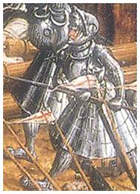 In
1512 Muscovy broke the peace by attacking Lithuania again with the
aim of capturing Smolensk. In December 1512 Grand Duke Basil himself
went to Smolensk, but it was ably defended and when a relief force
approached the Muscovites retreated. The Polish-Lithuanian Commander,
Ostrogski, ravaged the lands around Seversk and destroyed a 6,000
Muscovite force. In
1512 Muscovy broke the peace by attacking Lithuania again with the
aim of capturing Smolensk. In December 1512 Grand Duke Basil himself
went to Smolensk, but it was ably defended and when a relief force
approached the Muscovites retreated. The Polish-Lithuanian Commander,
Ostrogski, ravaged the lands around Seversk and destroyed a 6,000
Muscovite force.
In September 1513 Basil returned to Smolensk with
more powerful forces, and a six week siege of repeated assaults
was withstood. Polish forces drove the enemy from Vitebsk and Polock
and defeated a 14,000 force near Orsza thereby relieving Smolensk.
In June 1514 the Muscovites returned and on this
occasion the slow response of Polish-Lithuanian forces led to the
surrender of Smolensk. The Polish-Lithuanian army, of over 30,000
troops, led by Ostrogski, arrived and on the 8th September crushed
the 80,000 strong Muscovite army at Orsza
(8 September 1514). However this spectacular victory was not fully
exploited and Smolensk could not be retaken.
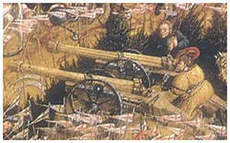 In
March 1515 Muscovy formed an alliance with the Livonian Knights,
but failed to take Vitebsk, while Polish forces recaptured Wielkie
Luki and Torpiec (1516). In 1517 the Polish expedition to Pskow
ended in defeat at the siege of Opoczka while the following year
brought a comprehensive victory for the Poles against the besieging
Muscovites at Polock. In
March 1515 Muscovy formed an alliance with the Livonian Knights,
but failed to take Vitebsk, while Polish forces recaptured Wielkie
Luki and Torpiec (1516). In 1517 the Polish expedition to Pskow
ended in defeat at the siege of Opoczka while the following year
brought a comprehensive victory for the Poles against the besieging
Muscovites at Polock.
In 1519 three Muscovite armies devastated Lithuania
as far as Krewno where the Polish-Lithuanian army was assembling.
While allied Crimean Tartars attacked Lvov and Lublin. However the
Muscovites failed to gain any significant results and a peace treaty
was signed in 1520.
1519-1521 Last
Teutonic War.
The Grand Master, persuaded by the Tsar, demanded changes in the
1466 treaty. In 1519 border skirmishes turned into a war, and the
Grand Master narrowly escaped an early defeat by the timely arrival
of Danish and German mercenaries. The Truce of 1521 coincided with
the Reformation, and the Catholic crusading order was decimated
by mass conversions to Lutheranism and the army melted away.
1524 Tartar and Turkish Invasions
In the Summer of 1524 first the Tartars and then the Turks pillaged
Volhynia, Podolia and Polish Ruthenia, reaching as far as the rivers
San and Bug. Hetman Tarnowski with meagre forces posted them further
East than before and managed to prevent the Tartars from continuing
any serious incursions into the Polish border lands. 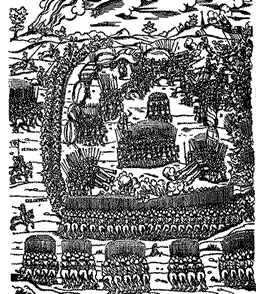 However
this only diverted them into the less protected Lithuanian lands. However
this only diverted them into the less protected Lithuanian lands.
1530-1531 War with Moldavia
Disputes for the throne of Hungary impacted upon Moldavia, once
Polish but now Hungarian, which was being pressurised by Turkey.
Peter Rares attacked Pokucie which he occupied in 1530. Zygmunt
sent Royal Grand Hetman Tarnowski, with 4,800 cavalry, 1,200 infantry
and 12 cannon, on a campaign to remove the Moldavians.
At Gwozdziec
he defeated a force of 6,000 and while returning home was surrounded
by a 50,000 with 50 cannon at Obertyn
(22 September 1531). Using the tabor
to superb effect Tarnowski swept them from the field.
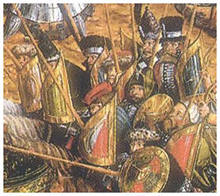 1534-1537
War with Muscovy 1534-1537
War with Muscovy
In March 1534, with civil strife in Russia, Hetman George Radziwill
with 20,000 Lithuanian forces attacked Muscovite territory, but
failed to gain any fruits. On the contrary during the winter of
1534-35 three Muscovite armies invaded Lithuania, devastating as
far as Wilno
and Nowogrodek. The Lithuanians obtained Polish support and 7,000
men under Tarnowski were sent to assist. In July their forces penetrated
the Seversk region and the fighting continued until the summer of
1536. Early in the following year a 5 year peace was concluded.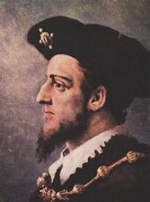
While his father Zygmunt Stary
was still alive
Zygmunt II Augustus Jagiello was crowned
King and in 1548 he took over the
reigns of power.
1563
First Northern War.
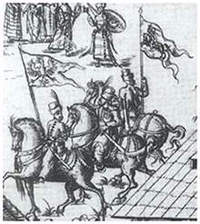 In
1558, despite an armistice, Ivan invaded
Livonia, devastating the countryside. The Livonian Knights sought
Polish-Lithuanian protection, but the Lithuanian forces struggled
to keep the Muscovites in check and succeeded only to defend Southern
Livonia. Poland agreed to come to the Order's aid and a voluntary
union was agreed. In January 1562 Muscovite forces invaded the Mscislaw
area which started a bitter war between Poland and Muscovy until
a peace in 1570. Initially Sweden was allied with Muscovy and Poland
with Denmark. Poland realised a fleet was needed to defend Livonia
and in 1563 a squadron of Polish privateers was formed. The war
only took a turn for the better, for Poland, in 1568 when Sweden
left the Muscovite alliance due to troubles with the Finns. A diplomatic
solution led to peace. In
1558, despite an armistice, Ivan invaded
Livonia, devastating the countryside. The Livonian Knights sought
Polish-Lithuanian protection, but the Lithuanian forces struggled
to keep the Muscovites in check and succeeded only to defend Southern
Livonia. Poland agreed to come to the Order's aid and a voluntary
union was agreed. In January 1562 Muscovite forces invaded the Mscislaw
area which started a bitter war between Poland and Muscovy until
a peace in 1570. Initially Sweden was allied with Muscovy and Poland
with Denmark. Poland realised a fleet was needed to defend Livonia
and in 1563 a squadron of Polish privateers was formed. The war
only took a turn for the better, for Poland, in 1568 when Sweden
left the Muscovite alliance due to troubles with the Finns. A diplomatic
solution led to peace.
1569
Act of Polish-Lithuanian Union
In July the 'Act of Union' was sealed between Lithuania and Poland
making them one 'Rzeczpospolita' (Republic or Commonwealth). Extracts:-
". . .
For closer Union, common and mutual brotherly love, in eternal common
defence of both countries, for the eternal glory of God, with eternal
thanks to the glory of these two excellent countries, Poland and
Lithuania . . . we have renewed that old alliance and agreed upon
the rules hereto set forth: . . . That the Kingdom of Poland and
the Grand Duchy of Lithuania are now a body one and indivisible,
a Republic one and indivisible consisting of two States and Nations,
which joined to form one People . . ."
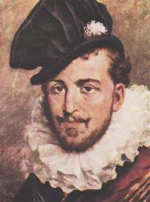 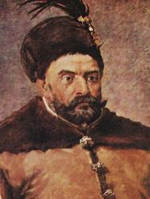 King
Zygmunt August died on 7th July 1572, and with no heir the period
of elected Kings began. King
Zygmunt August died on 7th July 1572, and with no heir the period
of elected Kings began.
Poland's first elected King -
Henri de Valois fled for the French throne three months after
coronation.
His successor was
Stefan Batory (Stephen Bathory) of Transylvania who was crowned
on 14th December 1575.
1576-1577 Gdansk
Rebellion
 The
port of Gdansk, which supported the Emperor's candidature, sought
the protection of the King of Denmark, rather than swear allegiance
to Batory, but Batory was not
a man to be trifled with. In September 1576 he stopped all commerce
with the city, moving all trade to Elbing, and declared the leaders
rebels. Gdansk retaliated by plundering the Abbey of Oliwa and the
Poles sent Jan Zborowski to deal with them. On 17th April 1577 Zborowski
with 1,350 cavalry, 1,050 infantry and a few cannon crushed rebel
mercenaries, comprising 3,100 landsknechts, 800 cavalry, 6-8,000
town militia and 7 cannon, at Lubieszow.
However further attacks and the blockade failed. It looked like
developing into a war of attrition, which suited neither side, and
the Peace of Malbork was negotiated in December, where Batory
received a hefty subsidy and Gdansk retained much of its freedom. The
port of Gdansk, which supported the Emperor's candidature, sought
the protection of the King of Denmark, rather than swear allegiance
to Batory, but Batory was not
a man to be trifled with. In September 1576 he stopped all commerce
with the city, moving all trade to Elbing, and declared the leaders
rebels. Gdansk retaliated by plundering the Abbey of Oliwa and the
Poles sent Jan Zborowski to deal with them. On 17th April 1577 Zborowski
with 1,350 cavalry, 1,050 infantry and a few cannon crushed rebel
mercenaries, comprising 3,100 landsknechts, 800 cavalry, 6-8,000
town militia and 7 cannon, at Lubieszow.
However further attacks and the blockade failed. It looked like
developing into a war of attrition, which suited neither side, and
the Peace of Malbork was negotiated in December, where Batory
received a hefty subsidy and Gdansk retained much of its freedom.
 2 2

|
|


Page 2

|

![]()

 In
March 1515 Muscovy formed an alliance with the Livonian Knights,
but failed to take Vitebsk, while Polish forces recaptured Wielkie
Luki and Torpiec (1516). In 1517 the Polish expedition to Pskow
ended in defeat at the siege of Opoczka while the following year
brought a comprehensive victory for the Poles against the besieging
Muscovites at Polock.
In
March 1515 Muscovy formed an alliance with the Livonian Knights,
but failed to take Vitebsk, while Polish forces recaptured Wielkie
Luki and Torpiec (1516). In 1517 the Polish expedition to Pskow
ended in defeat at the siege of Opoczka while the following year
brought a comprehensive victory for the Poles against the besieging
Muscovites at Polock.




 King
Zygmunt August died on 7th July 1572, and with no heir the period
of elected Kings began.
King
Zygmunt August died on 7th July 1572, and with no heir the period
of elected Kings began. 